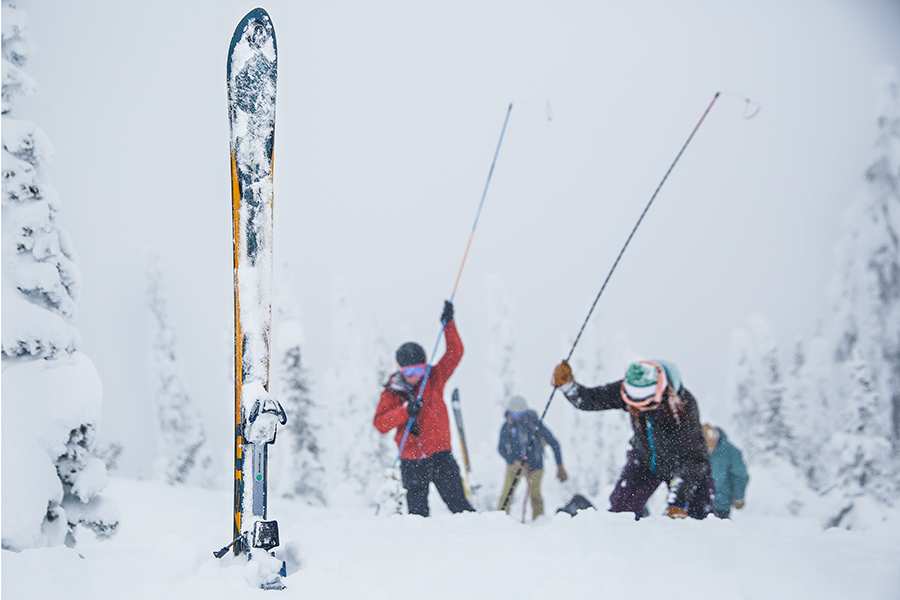An Avalanche of Education
FOFAC offers new avalanche classes this winter; forecasters say Flathead region's snowpack is at or above normal levels with hidden hazards
By Maggie Dresser
In response to a potential influx of backcountry users this winter, the Friends of the Flathead Avalanche Center (FOFAC) education committee held a meeting to brainstorm how to best prepare for the season and what they could do to keep recreationists as safe as possible.
“We realized we needed to up the education,” FOFAC Education Coordinator Meg Killen said. “We don’t want to see accidents, and if they happen, we want to see people are making the right decisions … We want to make sure we’re doing everything we can.”
To address the expected increase in backcountry use this winter, FOFAC has added more specific classes this season in addition to its regular avalanche awareness and Avalanche Level 1 and 2 certification courses that are offered every season.
New courses include tune-up classes to give students an opportunity to refresh material, partner rescue, motorized Avalanche Level 1 and topics classes, which range from avalanche dogs to ice climbing to a decision-making conversation with professional skier Cody Townsend.
“I think it’s an opportunity for folks to learn more,” Killen said. “Even if somebody doesn’t have a whole lot of background knowledge, the more education the better.”
While Flathead Avalanche Forecaster Mark Dundas has noticed a steady growth in backcountry use each year, he says the number of avalanche accidents hasn’t kept pace with the user growth.
“I don’t know if it’s education — I think that might play a part in it,” he said. “There’s certainly a lot more courses and class offerings that there wasn’t before.”
And despite a predicted influx in backcountry travelers this season, Dundas hasn’t noticed an obvious traffic uptick in comparison to last winter.
Dundas also points to the Flathead Avalanche Center’s growth in recent years as a possible reason for the low number of incidents. Until roughly five years ago, the center only posted forecasts twice a week and only had a few part-time forecasters. Now, four full-time forecasters post daily forecasts from December through April.
With a new weather station on Tunnel Ridge in the Flathead Range, forecasters say it’s filling in data points that were previously a “big, black hole,” in the forecasting region. The station was installed over the summer with funding from FOFAC, while the Mt. Aeneas weather station was installed last year. The stations also help the U.S. Forest Service monitor wildfires and Two Bear Air and other rescue services monitor wind speeds for flying.
At the end of December, Dundas says the Flathead forecasting area, which covers the Whitefish, Flathead and Swan mountain ranges and southern Glacier National Park, is either at or above average snow levels, according to area SNOTEL data.
Flathead Avalanche forecaster Clancy Nelson says while the snowpack varies across the region, it’s typically deeper in the Swan Range. But despite the generally shallower and colder snowpack in the Whitefish Range, the northern side near the Canadian border has a particularly deep snowpack so far this year.
While an atmospheric river event brought warm temperatures and wet, heavy snow and rain, triggering several natural avalanches right before Christmas, Dundas says the snowpack has somewhat stabilized since then and there are now different issues on the horizon.
“It created some very large destructive slides and our snowpack is getting beat up from that, but it didn’t have much left to give,” Dundas said. “Our main concern is a persistent slab problem. Buried layers deeper in the snowpack that are hard to trigger but when they do fail, they are much larger, dangerous and more destructive. So that’s our main concern right now.”
Dundas traces the persistent layers back to two separate weather events earlier this month. On Dec. 9, a warming event created a “thick, strong crust” surrounded by weak layers, which is now buried four feet deep, while Dec. 22 brought freezing rain and weak snow buried about a foot beneath the snow surface.
“These weak layers can fail,” Dundas said. “These are both layers we need to watch and monitor as our snowpack evolves.”
“Right now, you might be on the snow surface and everything is fine, but our current problem is buried beneath your feet and it’s a really tough problem to assess even for professional forecasters,” he added. “We always encourage people when we have these hidden dangers below the surface, we default to terrain selections that keep us safe with slopes that are 35 degrees or less and avoiding convexities where slopes roll over.”
Forecasters also encourage users to get the appropriate avalanche gear and training, check the avalanche forecast and know how to recognize unstable snow.
For the latest forecast or to register for classes, visit www.flatheadavalanche.org.